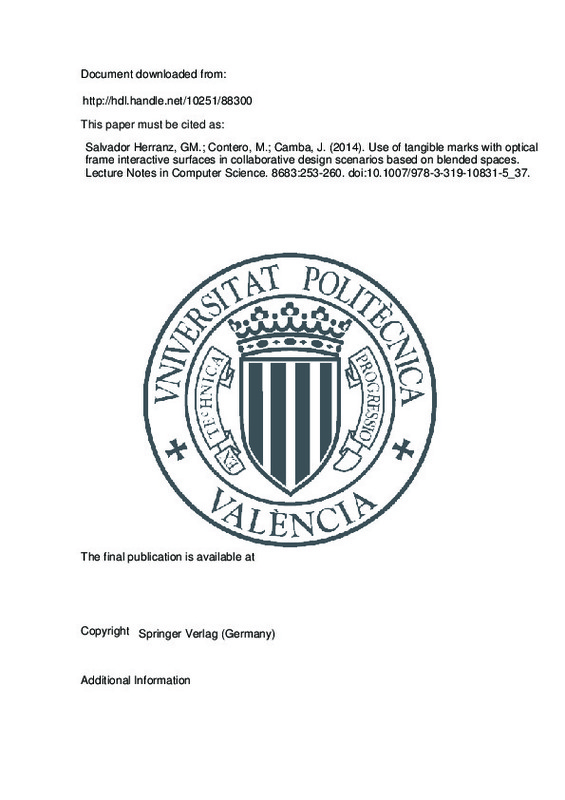JavaScript is disabled for your browser. Some features of this site may not work without it.
Buscar en RiuNet
Listar
Mi cuenta
Estadísticas
Ayuda RiuNet
Admin. UPV
Use of tangible marks with optical frame interactive surfaces in collaborative design scenarios based on blended spaces
Mostrar el registro sencillo del ítem
Ficheros en el ítem
| dc.contributor.author | Salvador Herranz, Gustavo Manuel
|
es_ES |
| dc.contributor.author | Contero, Manuel
|
es_ES |
| dc.contributor.author | Camba, Jorge
|
es_ES |
| dc.date.accessioned | 2017-09-29T12:49:10Z | |
| dc.date.available | 2017-09-29T12:49:10Z | |
| dc.date.issued | 2014 | |
| dc.identifier.issn | 0302-9743 | |
| dc.identifier.uri | http://hdl.handle.net/10251/88300 | |
| dc.description.abstract | [EN] Teamwork is habitual in engineering and industrial design projects, and it is particularly beneficial in the early stages of design in which the creativity plays a major role. In fact, many creativity techniques only make sense if they are developed in multidisciplinary work groups. In these early stages communication and exchange of ideas between the members of a team plays a key role, and therefore a major concern in this first working sessions is to avoid introducing barriers that may impair the communication process. Technology undoubtedly improves the exchange of information between team members, however sometimes can be a barrier in the early creative stages where communication must be direct and personal. Meetings where designers sit around a table to discuss or generate new ideas following some method of creativity (brainstorming, etc...) are usual. In this way the systems based on Natural Interfaces play a determinant role by enabling to hide the technology, making it transparent to the users, avoiding learning curves and thus interfering as little as possible in the creative process, but nonetheless exploiting the advantages that technology offers. | es_ES |
| dc.language | Inglés | es_ES |
| dc.publisher | Springer Verlag (Germany) | es_ES |
| dc.relation.ispartof | Lecture Notes in Computer Science | es_ES |
| dc.rights | Reserva de todos los derechos | es_ES |
| dc.subject | Human computer interfaces | es_ES |
| dc.subject | Natural interfaces | es_ES |
| dc.subject | Blended spaces | es_ES |
| dc.subject | Interactive surfaces | es_ES |
| dc.subject | Tabletops | es_ES |
| dc.subject.classification | EXPRESION GRAFICA EN LA INGENIERIA | es_ES |
| dc.title | Use of tangible marks with optical frame interactive surfaces in collaborative design scenarios based on blended spaces | es_ES |
| dc.type | Artículo | es_ES |
| dc.identifier.doi | 10.1007/978-3-319-10831-5_37 | |
| dc.rights.accessRights | Abierto | es_ES |
| dc.contributor.affiliation | Universitat Politècnica de València. Departamento de Ingeniería Gráfica - Departament d'Enginyeria Gràfica | es_ES |
| dc.description.bibliographicCitation | Salvador Herranz, GM.; Contero, M.; Camba, J. (2014). Use of tangible marks with optical frame interactive surfaces in collaborative design scenarios based on blended spaces. Lecture Notes in Computer Science. 8683:253-260. doi:10.1007/978-3-319-10831-5_37 | es_ES |
| dc.description.accrualMethod | S | es_ES |
| dc.relation.publisherversion | http://doi.org/10.1007/978-3-319-10831-5_37 | |
| dc.description.upvformatpinicio | 253 | es_ES |
| dc.description.upvformatpfin | 260 | es_ES |
| dc.type.version | info:eu-repo/semantics/publishedVersion | es_ES |
| dc.description.volume | 8683 | es_ES |
| dc.relation.senia | 286321 | |
| dc.description.references | Benyon, D.: Presence in blended spaces. Interacting with Compututers 24(4), 219–226 (2012) | es_ES |
| dc.description.references | Hoshi, K., Öhberg, F., Nyberg, A.: Designing blended reality space: conceptual foundations and applications. In: Proceedings of the 25th BCS Conference on Human-Computer Interaction, pp. 217–226 (2011) | es_ES |
| dc.description.references | Müller, D.: Mixed reality systems. International Journal of Emerging Technologies in Learning (iJET) 5 (S2) (2009) | es_ES |
| dc.description.references | Benyon, D., Mival, O.: Blended spaces for collaborative creativity. In: Proceedings of Workshop on Designing Collaborative Interactive Spaces, AVI 2012 (2012) | es_ES |
| dc.description.references | Müller-Tomfelde, C. (ed.): Tabletops - Horizontal Interactive Displays. Springer, London (2010) ISBN 978-1-84996-113-4 | es_ES |
| dc.description.references | Ishii, H., Ullmer, B.: Tangible bits: towards seamless interfaces between people, bits and atoms. In: Proceedings of the SIGCHI Conference on Human Factors in Computing Systems (CHI 1997), pp. 234–241 (1997), doi: 10.1145/258549 .258715 | es_ES |
| dc.description.references | Ishii, H.: Tangible user interfaces. In: Sears, A., Jacko, J.A. (eds.) The Human-Computer Interaction Handbook. Fundamentals, Evolving Technologies, and Emerging Applications, pp. 469–487 (2007) | es_ES |
| dc.description.references | Patten, J., Recht, B., Ishii, H.: Interaction Techniques for Musical Performance with Tabletop Tangible Interfaces. In: Advances in Computer Entertainment (2006) | es_ES |
| dc.description.references | Jordà, S., Geiger, G., Alonso, M., Kaltenbrunner, M.: The Reactable: exploring the synergy between live music performance and tabletop tangible interfaces. In: Proceedings of the 1st International Conference on Tangible and Embedded Interaction, pp. 139–146 (2007) | es_ES |
| dc.description.references | Veltkamp, R.C.: Shape matching: Similarity measures and algorithms. In: International Conference on Shape Modeling and Applications, SMI 2001, pp. 188–197 (2001) | es_ES |
| dc.description.references | Arkin, E.M., Paul, L., Keden, K., Mitchell, J.: An Efficiently Computable Metric for Comparing Poygonal Shapes. Technical Report 89-1007. Department of Computer Science. Cornell University (1989) | es_ES |
| dc.description.references | Salvador, G., Bañó, M., Pérez, D., Contero, M.: A distributed collaborative learning tool based on a conceptual map paradigm and natural interfaces applied to the case of product design studies. In: Proceedings of the Research in Engineering Education Symposium (2003) | es_ES |
| dc.description.references | Kaltenbrunner, M., Bovermann, T., Bencina, R., Costanza, E.: TUIO - A protocol for table-top tangible user interfaces. In: Proceedings of the 6th International Workshop on Gesture in Human-Computer Interaction and Simulation (2005) | es_ES |







![[Cerrado]](/themes/UPV/images/candado.png)

